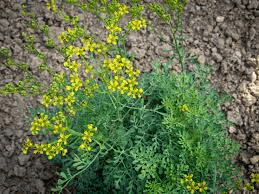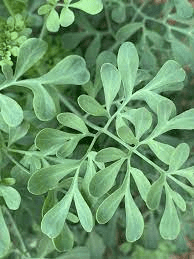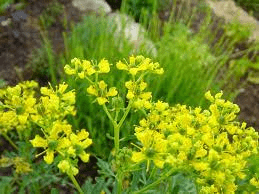Rue (Ruta graveolens) is a herbaceous plant belonging to the Rutaceae family. Native to the Mediterranean region, this aromatic herb has a long history of cultural, culinary, and medicinal uses. Rue is characterized by its bluish-green, deeply lobed leaves, and it produces small, yellow flowers that give way to fruits containing numerous seeds.
The scientific name, Ruta graveolens, reflects the plant’s strong and pungent fragrance. Rue has been cultivated and valued for centuries, and it plays a significant role in various cultural and historical contexts.
In culinary applications, Rue has been used sparingly due to its strong flavor. It was once a common culinary herb in Mediterranean and Middle Eastern cuisines, where it was employed to add a distinctive taste to dishes. However, its use in cooking has diminished over time, partly because excessive consumption may lead to adverse effects, including photosensitivity and skin irritation.
In traditional medicine, Rue has been utilized for its potential medicinal properties. The plant contains various compounds, including alkaloids, flavonoids, and essential oils, contributing to its therapeutic characteristics.
Rue has been historically employed to address a range of health issues, including digestive complaints, respiratory conditions, and menstrual disorders. However, it should be noted that the plant contains substances that may be toxic in high doses, and its medicinal use requires caution and expert guidance.
Rue has also been associated with folklore and superstitions. In some cultures, it was believed to have protective properties and was worn as an amulet to ward off evil spirits. Additionally, it was planted around homes to provide protection.
Due to its historical significance and potential medicinal properties, Rue is sometimes included in contemporary herbal remedies. It is available in various forms, such as extracts and tinctures, but its use should be approached with caution and under the guidance of healthcare professionals due to its potential toxicity.
In modern gardening, Rue is cultivated for its ornamental value, with its distinctive foliage and yellow flowers adding aesthetic appeal to gardens. However, individuals should be aware of its potential skin irritant properties and exercise caution when handling the plant.
In summary, Rue (Ruta graveolens) is a plant with a rich history, encompassing culinary, medicinal, and cultural dimensions. While it has been valued for its unique attributes, its use requires careful consideration due to the presence of potentially toxic compounds. As with any herb with traditional uses, it’s advisable to seek expert advice and exercise caution in its consumption or application.
The Botanical Description of Rue
1. Leaves: Rue (Ruta graveolens) is characterized by pinnately compound leaves, consisting of multiple leaflets with a distinctive bluish-green hue. The leaves are lance-shaped and emit a strong, aromatic fragrance when crushed.
2. Flowers: Rue produces small, yellow flowers arranged in clusters at the tips of the stems. The flowers have a unique fragrance and attract pollinators, contributing to the plant’s reproductive cycle.
3. Height and Structure: This perennial herb typically grows to a height of 2 to 3 feet, forming a bushy and upright structure. The stems are woody at the base and become more herbaceous toward the top.
4. Bark: Rue’s bark is not a prominent feature, as the plant’s appeal lies in its leaves and flowers. The bark is generally smooth and brownish-gray.
5. Growth Habit: Rue has a well-branched growth habit, creating a dense and compact appearance. The plant’s overall structure makes it suitable for both ornamental and medicinal cultivation.
6. Roots: The root system of rue is relatively shallow but extensive, providing stability to the plant. The roots absorb nutrients from well-draining soil.
7. Fruits: After flowering, rue develops small, capsule-like fruits containing seeds. These fruits contribute to the plant’s reproductive success and are often overlooked due to the prominence of the flowers.
8. Aroma: One of the defining features of rue is its strong, bitter aroma, which is present in both the leaves and the flowers. This aroma is a result of the plant’s essential oils.
9. Adaptability: Rue is known for its adaptability to various soil types and climates. It thrives in full sunlight but can tolerate partial shade, making it a versatile herb for different garden settings.
The Geographic Distribution of Rue
1. Mediterranean Region: Rue is native to the Mediterranean region, where it has been cultivated for centuries. The plant’s historical roots are deeply intertwined with the cultures of this area.
2. Europe: Rue has naturalized in many parts of Europe, and it is commonly found in regions with a mild climate. It has become a familiar sight in European gardens.
3. North Africa: The herb is also found in North African countries, extending its geographical distribution across the northern part of the African continent.
4. Western Asia: Rue has a presence in Western Asian countries, where it can be found in both wild and cultivated environments.
5. North America: Introduced to North America, rue has established itself in certain regions, particularly where the climate is conducive to its growth.
6. Cultivation Worldwide: Due to its ornamental and medicinal value, rue is cultivated in various parts of the world, adding to its global distribution.
7. Naturalized Areas: Rue has successfully naturalized in areas beyond its native range, demonstrating its resilience and ability to thrive in diverse conditions.
8. Garden Settings: The adaptability of rue has made it a popular choice in gardens worldwide, contributing to its presence in both private and public landscapes.
The Chemical Composition of Rue
1. Essential Oils: Rue contains essential oils, including rutin, limonene, and pinene, which contribute to its aromatic properties and potential medicinal benefits.
2. Alkaloids: The plant contains alkaloids such as arborinine and graveoline, which may have physiological effects on the human body.
3. Coumarins: Rue is a natural source of coumarins, including bergapten and xanthotoxin, which have been studied for their potential pharmacological properties.
4. Flavonoids: Flavonoids, such as quercetin and rutin, are present in rue and are known for their antioxidant and anti-inflammatory effects.
5. Acridine Derivatives: Rue is known to contain acridine derivatives, which contribute to the herb’s bitter taste and may have biological activities.
6. Tannins: Tannins, with their astringent properties, are found in rue and may play a role in medicinal applications.
7. Glycosides: Rue contains glycosides, adding to its chemical complexity and potential health benefits.
8. Furanocoumarins: Certain furanocoumarins, like psoralen, are present in rue and are of interest for their interactions with light.
9. Vitamins: Rue contains vitamins, including vitamin C, contributing to its nutritional profile.
10. Minerals: Essential minerals like calcium and potassium are found in rue, enhancing its overall composition.
11. Terpenes: Terpenes, such as limonene and pinene, contribute to the distinct aroma of rue and may have therapeutic properties.
12. Carotenoids: Rue contains carotenoids, which contribute to the plant’s color and may have antioxidant effects.
Read Also: 17 Medicinal Health Benefits Of Sweet Melilot (Melilotus officinalis)
The Medicinal Health Benefits Of Rue (Ruta graveolens)

1. Digestive Health: Rue has been traditionally used to support digestive health, alleviating symptoms such as indigestion and bloating.
2. Menstrual Disorders: The herb may have benefits for women’s health, addressing menstrual disorders and promoting regularity.
3. Anti-inflammatory Effects: Compounds like flavonoids and essential oils in rue contribute to its anti-inflammatory properties, potentially benefiting conditions like arthritis.
4. Respiratory Support: Rue has been used to address respiratory issues, offering relief from conditions like coughs and congestion.
5. Nervous System Health: Some traditional uses involve rue for promoting nervous system health and addressing symptoms of stress and anxiety.
6. Skin Conditions: Topical applications of rue may benefit certain skin conditions, with its anti-inflammatory and antimicrobial properties.
7. Immune System Boost: Compounds like vitamin C and flavonoids contribute to rue’s potential immune-boosting properties.
8. Antispasmodic Effects: Rue has been used to alleviate muscle spasms and cramps, potentially due to its alkaloid content.
9. Cardiovascular Support: Certain compounds in rue may support cardiovascular health, promoting proper blood circulation.
10. Antioxidant Properties: The presence of flavonoids and other antioxidants in rue contributes to its potential to combat oxidative stress.
11. Anti-diabetic Effects: Some studies suggest that rue may have anti-diabetic effects, although more research is needed to establish its efficacy.
12. Anti-cancer Potential: Preliminary research has explored rue’s potential anti-cancer properties, highlighting its role in cancer prevention.
13. Antimicrobial Action: Rue has demonstrated antimicrobial effects in certain studies, indicating its potential in fighting infections.
14. Pain Relief: Traditional use of rue includes pain relief, making it a remedy for various types of pain, including headaches and joint discomfort.
15. Vision Support: Compounds like carotenoids in rue may contribute to vision support and overall eye health.
16. Antiviral Properties: Rue has been investigated for its antiviral properties, suggesting a role in fighting viral infections.
17. Liver Detoxification: Compounds in rue may support liver health by promoting detoxification processes.
18. Anti-anxiety Effects: Traditional uses include rue for its potential anti-anxiety effects, contributing to mental well-being.
19. Wound Healing: Rue’s antimicrobial and anti-inflammatory properties may aid in wound healing and skin regeneration.
The Methods of Usage to Achieve the Provided Health Benefits Of Rue (Ruta graveolens)
1. Herbal Tea: Prepare a rue herbal tea by steeping dried leaves in hot water, promoting digestive health and relaxation.
2. Tinctures: Rue tinctures, made by extracting active compounds in alcohol, offer a concentrated form for medicinal use.
3. Poultices: Create a poultice by crushing rue leaves and applying them topically to address skin conditions or provide localized pain relief.
4. Aromatherapy: Inhale the aroma of rue essential oil for its potential calming effects on the nervous system.
5. Culinary Use: In some cultures, rue is used as a culinary herb, adding a unique flavor to dishes and potentially offering digestive benefits.
6. Capsules or Tablets: Rue supplements are available in capsule or tablet form, providing a convenient way to incorporate its health benefits into a daily routine.
7. Salves or Ointments: Infuse rue into a salve or ointment for topical application, particularly beneficial for skin conditions.
8. Herbal Baths: Add rue to bathwater for a soothing experience that may contribute to relaxation and overall well-being.
9. Compresses: Soak a cloth in rue-infused water and apply it as a compress to address localized pain or inflammation.
10. Culinary Garnish: Use fresh rue leaves as a garnish in salads or dishes for a touch of flavor and potential health benefits.
The Side Effects Of Using Rue Medicinal Plant
1. Photosensitivity: Due to the presence of furanocoumarins, rue may increase sensitivity to sunlight, leading to skin reactions.
2. Gastrointestinal Discomfort: Some individuals may experience stomach upset or nausea when using rue, particularly in high doses.
3. Allergic Reactions: Allergic reactions to rue, though rare, may include skin rashes, itching, or swelling. Discontinue use if such reactions occur.
4. Central Nervous System Effects: High doses of rue may lead to central nervous system effects, including dizziness or headaches.
5. Pregnancy and Breastfeeding: Rue is contraindicated during pregnancy, as it may stimulate uterine contractions. Breastfeeding individuals should also avoid its use.
6. Blood Pressure Effects: Rue may impact blood pressure, and individuals with hypertension should use it with caution.
7. Kidney Function: Prolonged or excessive use of rue may impact kidney function, and individuals with kidney issues should exercise caution.
8. Interactions with Medications: Rue may interact with certain medications, including anticoagulants and antihypertensives, so consultation with a healthcare professional is crucial.
9. Neurological Effects: Some individuals may experience neurotoxic effects with high doses of rue, affecting the nervous system.
10. Avoiding Essential Oil Ingestion: Ingesting rue essential oil is not recommended due to its potency and potential toxicity.
11. Respiratory Distress: Individuals with asthma or respiratory conditions should use rue cautiously, as it may exacerbate respiratory distress.
12. Liver Health: High doses of rue may impact liver function, and individuals with liver issues should use it with caution.
13. Photosensitivity: Rue may increase the risk of photosensitivity, making individuals more prone to sunburn and skin reactions.
Read Also: 19 Medicinal Health Benefits Of Thuja Occidentalis (Eastern White Cedar)
The Scientific Research and Studies of Rue

1. Antimicrobial Studies: Scientific research has explored rue’s antimicrobial properties, suggesting its potential in fighting various pathogens.
2. Anti-inflammatory Effects: Studies have investigated the anti-inflammatory effects of rue, contributing to its traditional use for conditions like arthritis.
3. Analgesic Comparisons: Rue’s analgesic effects have been compared to conventional pain medications in several studies, demonstrating its potential in pain management.
4. Neurological Impact: Research has explored the neurological impact of rue, focusing on its potential effects on the central nervous system.
5. Anti-diabetic Investigations: Some studies have investigated rue’s potential in managing diabetes, exploring its effects on blood sugar levels.
6. Cardiovascular Health: Scientific research has explored the impact of rue on cardiovascular health, particularly its effects on blood circulation.
7. Skin Conditions: Studies have investigated the use of rue extracts in addressing certain skin conditions, highlighting its anti-inflammatory and antimicrobial effects.
8. Respiratory Health: Research has explored the effects of rue on respiratory health, suggesting potential benefits for conditions like coughs and congestion.
9. Vision and Eye Health: Studies have explored rue’s potential in supporting vision and overall eye health, focusing on its carotenoid content.
10. Anti-anxiety Effects: Some studies have explored rue’s potential anti-anxiety effects, suggesting a role in promoting mental well-being.
11. Immune System Modulation: Scientific research has investigated the modulation of the immune system by rue, exploring its potential in supporting immune function.
The Safety Precautions and Recommendations In Using Rue Medicinal Plant
1. Dosage Guidelines: Follow recommended dosage guidelines to avoid potential side effects and ensure safe usage.
2. Consultation with Healthcare Professionals: Individuals with pre-existing medical conditions or those on medications should consult healthcare professionals before using rue.
3. Monitoring Blood Pressure: Individuals with hypertension should monitor their blood pressure regularly when using rue.
4. Pregnancy and Breastfeeding: Pregnant and breastfeeding individuals should avoid the use of rue due to potential uterine stimulation.
5. Kidney Function Monitoring: Individuals with kidney issues should use rue with caution and monitor kidney function regularly.
6. Essential Oil Use: Ingesting rue essential oil is not recommended due to its potency and potential toxicity.
7. Photosensitivity Precautions: Rue may increase sensitivity to sunlight, so users should take precautions, such as using sunscreen and avoiding prolonged sun exposure.
8. Respiratory Conditions: Individuals with respiratory conditions should use rue cautiously, as it may exacerbate respiratory distress.
9. Liver Health Monitoring: Individuals with liver issues should use rue with caution and monitor liver function regularly.
10. Neurological Effects Monitoring: High doses of rue may impact the central nervous system, and users should be vigilant for any neurological effects.
11. Allergic Reaction Awareness: Be aware of potential allergic reactions and discontinue use if skin reactions or other allergic symptoms occur.
12. Interaction with Medications: Rue may interact with certain medications, and users should inform healthcare professionals about its use to avoid potential interactions.
FAQs About Rue Medicinal Plant
1. Can rue be used for anxiety relief?
While some studies suggest potential anti-anxiety effects, individuals seeking anxiety relief should consult healthcare professionals for personalized advice.
2. Is rue safe for children?
Rue is generally not recommended for children due to its potential toxicity and effects on the developing system.
3. Can rue be used for respiratory conditions like asthma?
Individuals with respiratory conditions should use rue cautiously, as it may exacerbate symptoms in sensitive individuals.
4. Can rue be taken on an empty stomach?
While rue can be taken on an empty stomach, some individuals may experience gastrointestinal discomfort, so taking it with food is advisable.
5. Is rue addictive?
Rue is not known to be addictive; however, responsible and informed use is essential.
6. Can rue be used for chronic pain conditions?
Rue has been traditionally used for pain relief, but individuals with chronic pain should consult healthcare professionals for personalized advice.
7. Can rue be used topically for skin conditions?
Topical applications of rue may benefit certain skin conditions, but individuals with skin conditions should seek advice from dermatologists.
8. Can rue be used in combination with other herbal remedies?
Combining rue with other herbal remedies should be done with caution, and it’s recommended to seek guidance from a healthcare professional.
9. Can rue be used during menstruation?
Rue has been traditionally used for women’s health, but individuals should consult healthcare professionals before using it during menstruation.
10. How long does it take for rue to show medicinal effects?
The onset of medicinal effects with rue can vary, and individual responses may differ based on factors such as dosage and frequency of use.
11. Can rue be used for immune system support?
Compounds like vitamin C and flavonoids in rue may contribute to immune system support, but individuals should adopt a holistic approach to immune health.
12. Is rue safe for individuals with liver conditions?
Those with liver conditions should use rue cautiously, monitoring liver function regularly and consulting healthcare professionals.
13. Can rue be used for vision support?
Compounds like carotenoids in rue may contribute to vision support, but maintaining overall eye health is essential.
14. Can rue be used during a detoxification regimen?
Rue’s potential impact on liver detoxification processes may make it suitable for inclusion in detox regimens, but individuals should consult healthcare professionals.
15. Can rue be taken with food for better absorption?
Taking rue with food is advisable, as it may help minimize gastrointestinal discomfort and enhance absorption.
16. Can rue be used for wound healing?
Rue’s antimicrobial and anti-inflammatory properties may aid in wound healing and skin regeneration.
17. Can rue be used as a culinary herb regularly?
While rue is used as a culinary herb in some cultures, its strong flavor suggests moderate and occasional use for culinary purposes.
18. Can rue be used for respiratory infections?
Rue’s antimicrobial effects may be beneficial for respiratory health, but individuals with infections should seek appropriate medical treatment.
Read Also: Everything You Need to Know Before Starting a Cattle Business

